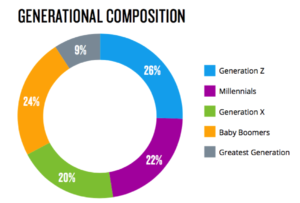Neilsen’s most recent report from July 2017 indicates that Generation Z now accounts for 26 percent of the total media audience, which makes them the largest audience segment (Sterling, 2017). This shift in demographics has been long anticipated, but the time has finally arrived, so current and future marketers better take notice.
According to Sterling, members of Generation Z were born between 1997 and 2015 (Sterling, 2017), which means that they are beginning to enter college and the workplace (Granados, 2017). As the world’s largest, most diverse generation (Klepacki, 2017) that is a quarter of the population in the United States (Granados, 2017), they can no longer be generalized as children who are similar to millennials merely because they both grew up with technology. It is true that generation Z grew up with technology, but the way they use it and their outlook on life is much different.
One important distinction between these two generations is that Generation Z is widely considered to have a more financially conservative outlook than millennials, because they were raised during a time when their parents struggled through the Great Recession (Klepacki, 2017). They are also interested in working hard and saving money for financial stability, whereas millennials are more inclined to take on debts and baby-boomers hold on to money as a status symbol (Klapacki, 2017).
Another difference between the two generations lies in their purchasing behavior. Whereas millennials prefer to convenience of purchasing goods and services online, Gen-Z tends to prefer physically going to stores where they can be exposed to products and brands that they like. The outlook of wanting to work hard to save money combined with the behavior of in-person purchasing may seem as if Gen Z is more similar to baby-boomers upon first glance. However, as Klepacki points out, Gen Z is arguably the first generation to know no other existence than one that involves technology, so while they will physically go to stores, they are also heavily involved in social media (Klepacki, 2017).
Finally, Klepacki finds that Gen Z prefers to use mobile devices for the majority of their media consumption (Klepacki, 2017). Mobile has been a major emerging market for years, but this research indicates that there will be strong growth in this area for years to come as Gen Z prefers it over television and even logging in to computers (Klepacki, 2017). In terms of social media on mobile devices, the most popular websites are Snapchat, Instagram and Facebook (Klepacki, 2017).
These blended generational characteristics beg the question, will Gen Z require new approaches for marketers to reach them, or can they be treated with similar approaches to previous generations?
References
Granados, N. (2017, Jun 20). Gen Z media consumptions: It’s a lifestyle, not just entertainment. Forbes. Retrieved from http://www.mobilemarketer.com/news/the-emerging-portrait-of-gen-z/445739/
Klepacki, Laura (2017, June 26). The emerging portrait of Gen Z: Expect a change in direction as the world’s most influential consumers – who combine technological prowess with an old-school mindset – grow up. Mobile Marketer. Retrieved from http://www.mobilemarketer.com/news/the-emerging-portrait-of-gen-z/445739/
Sterling, G. (2017, July 17). Move over millennials, Gen-Z now the largest single population segment. Marketing Land. Retrieved from http://marketingland.com/move-millennials-gen-z-now-largest-single-population-segment-219788


2 Responses to It’s Official: Generation Z Is Now The Largest Audience Segment